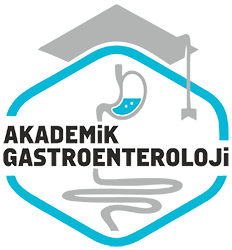Aralik 2020
Gastroskopik girisimlerde sedoanaljezi uygulanan anemik hastalarda entegre pulmoner indeks ve solunum komplikasyonlarindaki değeri
Integrated pulmonary index and its value in respiratory complications in anemic patients undergoing sedoanalgesia in gastroscopic interventions
- Ana Sayfa
- Sayılar
- Aralik 2020
- Gastroskopik girisimlerde sedoanaljezi uygulanan anemik hastalarda entegre pulmoner indeks ve solunum komplikasyonlarindaki değeri...
Özet
Giriş ve Amaç: Endoskopik prosedürlerde sedoanaljeziye bagli komplikasyonlar morbiditenin önde gelen nedenlerindendir. Dolasim, solunumfonksiyonu ve ventilasyonun izlenmesi önemlidir. Entegre pulmonerindeks, periferik oksijen satürasyonu, end-tidal karbondioksit konsantrasyonu, solunum sayisi ve kalp hizi değerlerinin es zamanli ortak analiziyle elde edilen bir parametredir. Entegre pulmoner indeks tek değervererek iyi bir monitörizasyon ve takip yapmamizi saglar. Çalışmamızdaanemik hastalarda sedoanaljezi ile yapılan gastroskopik Girişimlerde entegre pulmoner indeks skorlarininin tespiti ile meydana gelebilecek solunumsal komplikasyonlarin takibindeki önemini incelemeyi amaçladık. Gereç ve Yöntem: Gastroskopi Girişimlerinde sedoanaljezi uygulananhastalar iki gruba ayrıldı: Grup I (n: 155) anemisi bulunan, Grup II (n:158) anemisi bulunmayan hastalar. Hastalara ait demografik veriler ileislem öncesi bazal 0., 5. ve 10. dakika ortalama arteriyal kan basinci,kalp hizi, periferik oksijen satürasyonu, solunum sayisi, end-tidal karbondioksit konsantrasyonu, entegre pulmoner indeks değerleri tespit edildi.Takip edilen bu parametreler üzerinden solunumsal komplikasyonlar belirlenerek iki grup karsilastirildi. Bulgular: Cinsiyet açısından 313 hastanın %49’u erkek, %51’i kadın olup yaş ortalaması 53±16.5’di. Gruplararasında 0., 5. ve 10. dakikalar için entegre pulmoner indeks skoru,periferik oksijen satürasyonu, solunum sayisi, end-tidal karbondioksitkonsantrasyonu ve ortalama arteriyal kan basinci açısından anlamli farkyoktu (p >0.05). Grup II için, kalp hizi tüm ölçüm zamanlarinda GrupI’den yüksek bulundu (p <0.001). Ayrıca iki grup arasında, entegre pulmoner indeks ve diğer monitörizasyon parametreleri üzerinden tanımlanan solunum komplikasyonlari açısından anlamli fark bulunmadı (p>0.05). Sonuç: Gastroskopik Girişimlerin sedoanaljezi uygulamalarinda,anemi solunumsal komplikasyonlarin ortaya çikmasi açısından önemlibir sorun olusturmamıştır. Entegre pulmoner indeks monitörizasyonunun, gastroskopi Girişimlerinde sedoanaljezi uygulanan anemik ve anemik olmayan hastalarda dogru ve güvenli bir monitörizasyon teknigiolduğu kanaatindeyiz.
Abstract
Background and Aims: Complications due to sedoanalgesia are theleading cause of morbidity in endoscopic procedures. Thus, monitoringof circulation, respiratory function, and ventilation is important. integrated pulmonary index offers good monitoring and follow-up by providingthe only value obtained by simultaneous joint analysis of peripheral oxygen saturation, end-tidal carbon dioxide concentration, and respiratoryand heart rate values. The objective was to analyze the integrated pulmonary index score and its place in the follow-up of respiratory complications that may occur in anemic patients undergoing sedoanalgesiaduring gastroscopic procedures. Materials and Methods: Patients whounderwent sedoanalgesia during gastroscopic procedures were dividedinto two groups: Group I (n: 155) with anemia and Group II (n: 158)without anemia. Based on the demographic data of the mean arterial blood pressure, heart rate, peripheral oxygen saturation, respiratoryrate, and end-tidal carbon dioxide concentration of the patients, theintegrated pulmonary index values were determined at the beginningand the 5th and 10th minutes of the procedure. Moreover, respiratorycomplications in both groups were compared using these parameters.Results: In this study, 49% of 313 patients were male, 51% of femaleand the mean age was 53±16.5. There was no substantial difference between the groups with respect to the integrated pulmonary index score,peripheral oxygen saturation, respiratory rate, end-tidal carbon dioxideconcentration, and mean arterial blood pressure at the beginning andthe 5th and 10th minutes of the procedure (p >0.05). In Group II, theheart rate was found to be higher than in Group I in all time frames (p<0.001). There was no substantial difference between the two groupsin terms of respiratory complications as described by the integrated pulmonary index and other monitoring parameters (p >0.05). Conclusion:In sedoanalgesia applications of gastroscopic interventions, anemia didnot pose a major problem in the emergence of respiratory complications. Integrated pulmonary index monitoring is known to be an accurate and safe monitoring technique in anemic and non-anemic patientsundergoing sedoanalgesia in gastroscopic procedures.



